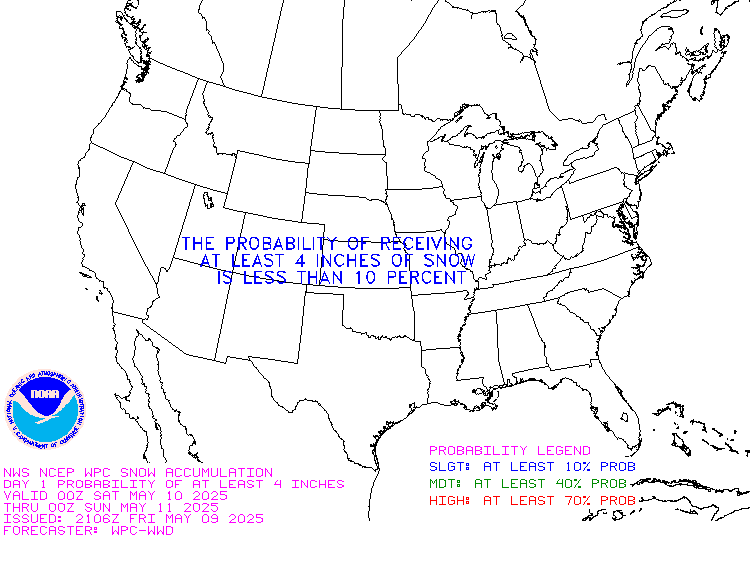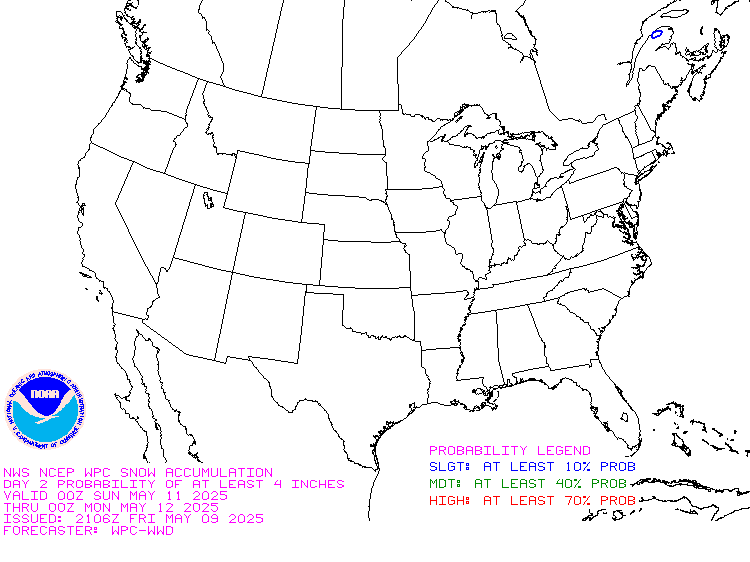It is difficult to find a more comprehensive Weather Outlook anywhere else with the ability to get a local 10-day Forecast also.
This article focuses on what we are paying attention to in the next 48 to 72 hours. The article also includes weather maps for longer-term U.S. outlooks and a six-day World weather outlook which can be very useful for travelers.
First the NWS Short Range Forecast. The afternoon NWS text update can be found here but it is unlikely to have changed very much. The images in this article automatically update.
Short Range Forecast Discussion
NWS Weather Prediction Center College Park MD
Mon Apr 08 2024
Valid 12Z Mon Apr 08 2024 – 12Z Wed Apr 10 2024…Northern New England remains the best location for clear viewing of the
total solar eclipse this afternoon……Lingering wet snow across the Northern Plains expected to taper off
later today while locally moderate rain moves across the Upper Midwest……Heavy rain, flash flooding and severe weather threat emerging across
the Southern Plains to the lower Mississippi Valley on Tuesday……Critical fire danger shifts southward into western Texas by Tuesday…
As the long-anticipated total solar eclipse scheduled to take place this
afternoon, the weather pattern across the U.S. is entering a transition
period from one that consists of a winter storm across the North to heavy
rain and severe thunderstorms across the South. The low pressure system
that has brought snow, high winds, and severe weather to various locations
across the northern and central U.S. will continue to weaken and track
northeast across the upper Midwest today, and then move into southern
Canada on Tuesday. Lingering wet snow across the Northern Plains is
expected to taper off later today while locally moderate rain moves across
the Upper Midwest.Monday morning will feature showers and embedded thunderstorms across the
Great Lakes down into the Ohio Valley, Tennessee Valley and the lower
Mississippi Valley well in advance of the low pressure system and near the
trailing cold front. Meanwhile, moisture from the Gulf of Mexico is
beginning to return to the western Gulf states. Southern Texas will
likely wake up to fair conditions this morning but will likely followed by
a rapid untimely increase of clouds this morning into the afternoon prior
to the arrival of the solar eclipse. In contrast, northern New England
remains to be the region where cloud cover will likely be minimized along
the path of totality this afternoon as the nor’easter moves farther out
into the Atlantic. It appears that other locations in between will have a
fair chance of cloud covers at various levels, although locations across
the Midwest could see breaks in the clouds or high thin clouds during the
time of totality.Monday night into Tuesday will likely see the threat of heavy rain
blossoming across the South from eastern Texas/eastern Oklahoma expanding
eastward into the lower Mississippi Valley in response to a potent upper
trough approaching from the southern Rockies that will interact with the
influx of Gulf moisture. A few inches of rain will likely be common from
northern Louisiana into southern Arkansas through Wednesday morning with
this setup. In addition, severe thunderstorms are also expected to
develop within the heavy rain area from Tuesday morning onward into
Wednesday morning when a low pressure system is forecast to develop over
Texas. The heaviest rains and severe storms should begin to head farther
east by Wednesday morning into the Mid-South as the low pressure system
intensifies and tracks toward the east-northeast.Meanwhile, moisture from the next Pacific system is forecast to bring the
next round of precipitation into the Pacific Northwest by later today and
spread into the northern Rockies on Tuesday. Much of the Southwest into
the Four Corners will remain dry with some gusty winds as a dry cold front
passes through. As for fire weather, it appears that the area of Critical
Risk of Fire Weather will be confined to western Texas per the Storm
Prediction center.Forecast high temperatures will tend to be at or above average and mild to
warm over much of the central/eastern U.S. today ahead of the system over
the Midwest/Plains. The greatest anomalies will be in the lower Great
Lakes vicinity, where temperatures into the 60s and 70s are upwards of
15-20 degrees above normal. The frontal boundary sagging southward and
increasing coverage of precipitation chances will bring cooler
temperatures from the Tennessee Valley west through the ArkLaTex and into
portions of the Southern Plains/Rockies Tuesday. Temperatures are forecast
to warm up by 10-15 degrees over the Northern Plains Tuesday following one
more chilly day on Monday. An expanding area of warm, above average
temperatures will spread inland from California into the Great Basin
Tuesday as an upper-level ridge builds in.
To get your local forecast plus active alerts and warnings click HERE and enter your city, state or zip code.
Above is a 72 hour animation of the forecast. Learn about wave patterns HERE.
Then, looking at the world and of course, the U.S. shows here also. Today we are looking at precipitation.
Please click on “Read More” below to access the full Daily Report issued today.
| Notices: What would you like to learn about? Please provide that to me via the comment section at the end of the article. |
Now more detail on the 48-Hour Forecast (It is a 48 to 72 Hour Forecast actually)
Daily weather maps. The Day 1 map updates twice a day and the Day 2 and 3 maps update only once a day. These maps update automatically. But if that does not happen, you can get updates by clicking HERE
TODAY (or late in the day the evening/overnight map will appear) (Key to surface fronts shown on maps and you will then also be able to insert a city name or zip code and get a local NWS forecast).
TOMORROW
NEXT DAY
This animation shows how things may play out over the next 60 hours. To update click here.
The NWS Climate Prediction Center’s: Watches, Warnings, and Advisories plus other information can be found HERE. We post at least one of those updates daily, sometimes both. The Highlights are shown in the lede paragraph of this article.
ATMOSPHERIC RIVERS
This tells us what is approaching the West Coast. Click HERE to update If I have not gotten around to doing the update. Here is some useful information about Atmospheric Rivers.
Below is the current five-day cumulative forecast of precipitation (Updates can be found HERE)
Ski SnowReports
New Feature – Ski Reports. It is difficult to find reports that auto-update on-screen (and they are very long) but these links will get you to them – If you have additional suggestions make them in the comments section after every Econcurrents Article and we may add those links. We will try to not have too much overlap as that can add to the confusion.
Snow Forecasts. And remember this shows natural snow. Ski resorts also make their own snow.
Day 1

Day 2

Additional snow information can be found here, here, here, and here. The second link provides animations.
Now we look at Intermediate-Term “Outlook” maps for three time periods. Days 6 – 10, Days 8 – 14, and Weeks 3 and 4. An outlook differs from a forecast based on how NOAA uses these terms in that an “outlook” presents information as deviation from normal and the likelihood of these deviations.
Below are the links to obtain updates and additional information. They are particularly useful if you happen to be reading this article significantly later than when it was published. I always try to provide readers with the source of the information in my articles. These links may also be useful for those viewing this article on a cell phone or other small screen.
| Days 6 – 10 (shown in Row 1) | Days 8 – 14 (Shown in Row 2) | Weeks 3 and 4 (Shown in Row 3 but updates only on Fridays) |
| https://www.cpc.ncep.noaa. gov/products/predictions/610day/ | https://www.cpc.ncep .noaa.gov/products/predictions/814day/ | https://www.cpc.ncep.noaa.gov/products/predictions/WK34/ |
Showing the actual maps. They should now update automatically. The Week 3 – 4 Outlook only updates on Fridays. So below is what I call the Intermediate-term outlook. On Fridays, it extends out 28 Days. That declines day by day so on Thursday it only looks out 22 days until the next day when the Week 3 – 4 Outlook is updated and this extends the outlook by one additional week.
| 6–
10
|
|
|
| 8–
14 |
|
|
| 3–
4 |
|
|
HAZARDS OUTLOOKS
Click here for the latest complete Day 3 -7 Hazards forecast which updates only on weekdays. Once a week probably Monday or Tuesday I will update the images. I provided the link for readers to get daily updates on weekdays. Use your own judgment to decide if you need to update these images. I update almost all the images Friday Night for the weekend edition of this Weather Report. So normally readers do not need to update these images but if the weather is changing quickly you may want to.
Temperature month to date can be found at https://hprcc.unl.edu/products/maps/acis/MonthTDeptUS.png
Precipitation month to date can be found at https://hprcc.unl.edu/products/maps/acis /MonthPNormUS.png
World Forecast [that website is has been intermittent so be patient]
Below are the Day 1 -3 and 4-6 forecasts for temperature and precipitation. Updates and much additional information can be obtained HERE
World Temperature Anomalies
World Accumulated Precipitation
This information is provided by the University of Maine. They draw upon many different sources. There is a lot of information available at the link provided. I have just provided two useful forecasts. There are probably over a hundred different forecasts available from this source.
Worldwide Tropical Forecast (This is a NOAA Product)
This graphic updates on Tuesdays) If it has not been updated, you can get the update by clicking here Readers will only have to do that if they are reading this article much later than the date of it being published.
Information on Tropical Storms can be found HERE. Western Pacific information can be found HERE. Note that unless there is an out-of-season storm the below images will not update until the National Hurricane Center starts their seasonal update of these maps on June 1. I include them simply because there can be an out-of-season event in which case it should show up in these maps.


–
| I hope you found this article interesting and useful. |
–
